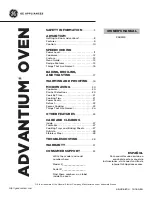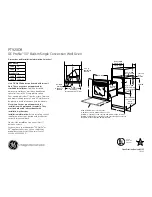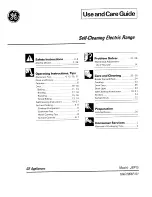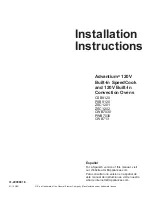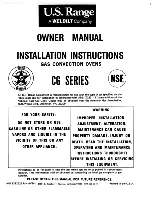
44
SAFETY
IMPORTANT SAFETY INSTRUCTIONS
The safety instructions below will tell you how to use your oven to avoid harm to yourself or damage to your
oven.
WARNING
-
To reduce the risk of burns, electric shock, fire, injury to persons, or exposure to
excessive microwave energy:
1.
Read all instructions before using the appliance.
2.
Read and follow the specific
PRECAUTIONS TO AVOID
POSSIBLE EXPOSURE TO EXCESSIVE
MICROWAVE ENERGY
found on page 3 of this manual.
3
. This appliance must be grounded. Connect only to properly grounded outlet.
See
GROUNDING INSTRUCTIONS
found on page 3 of this manual .
4.
Install or locate this appliance only in accordance with the provided installation instructions.
5
. Some products, such as whole eggs and sealed containers – for example, closed glass jars are able to
explode and should not be heated in this oven.
6.
Use this appliance only for its intended use as described in the manual. Do not use corrosive chemicals
or vapors in this appliance. This type of oven is specifically designed to heat, cook, or dry food. It is not
designed for industrial or laboratory use.
7.
As with any appliance, close supervision is necessary when used by children.
8.
Do not operate this appliance if it has a damaged cord or plug, if it is not working properly, or if it has been
damaged or dropped.
9
. This appliance should be serviced only by qualified service personnel. Contact the nearest authorized service
facility for examination, repair, or adjustment.
10.
Do not cover or block any openings on the appliance.
11
. Do not store this appliance outdoors. Do not use this product near water – for example, near a kitchen sink,
in a wet basement, near a swimming pool, or similar location.
12
. Do not immerse cord or plug in water.
13.
Keep cord away from heated surfaces.
14
. Do not let cord hang over the edge of a table or counter.
15
. When cleaning surfaces of door and oven that come together on closing the door, use only mild, nonabrasive
soaps or detergents applied with a sponge or soft cloth.
16
. To reduce the risk of fire in the oven cavity:
a. Do not over cook food. Carefully attend appliance when paper, plastic, or other combustible materials are
placed inside the oven to facilitate cooking.
b. Remove wire twist-ties from paper or plastic bags before placing bag in oven.
c. If materials inside the oven ignite,
KEEP OVEN DOOR CLOSED,
turn oven off, and disconnect the power
cord or shut off power at the fuse or circuit breaker panel.
d. Do not use the cavity for storage purposes. Do not leave paper products, cooking utensils, or food in
the cavity when not in use.
17.
Liquids, such as water, coffee, or tea are able to be overheated beyond the boiling point without appearing to
be boiling. Visible bubbling or boiling when the container is removed from the microwave oven is not always
present. THIS COULD RESULT IN VERY HOT LIQUIDS SUDDENLY BOILING OVER WHEN THE CON-
TAINER IS DISTURBED OR A SPOON OR OTHER UTENSIL IS INSERTED INTO THE LIQUID. To reduce
the risk of injury to persons; 1) Do not overheat the liquid. 2) Stir the liquid both before and halfway through
heating it. 3) Do not use straight-sided containers with narrow necks. 4) After heating, allow the container to
stand in the microwave oven for a short time before removing the container. 5) Use extreme care when
inserting a spoon or other utensil into the container.
18.
Avoid heating small-necked containers such as syrup bottles.
19.
Avoid using corrosive and vapors, such as sulfide and chloride.
20.
Liquids heated in certain shaped containers (especially cylindrical-shaped containers) may become overheat-
ed. The liquid may splash out with a loud noise during or after heating or when adding ingredients (instant
coffee, etc.), resulting in harm to the oven and possible injury. In all containers, for best results, stir the liquid
several times before heating. Always stir liquid several times between reheatings.
SAVE THESE INSTRUCTIONS
Summary of Contents for MAR1140W
Page 1: ...MAR1140W B website http us lgservice com ...
Page 2: ...2 TABLE OF CONTENTS ...
Page 7: ... MAR1140W B 7 UNDERSTANDING YOUR MICROWAVE OVEN ...
Page 11: ...11 USING YOUR MICROWAVE OVEN ...
Page 12: ...12 USING YOUR MICROWAVE OVEN L L ...
Page 13: ...13 USING YOUR MICROWAVE OVEN ...
Page 14: ...14 USING YOUR MICROWAVE OVEN ...
Page 15: ...15 USING YOUR MICROWAVE OVEN ...
Page 18: ...18 USING YOUR MICROWAVE OVEN ...
Page 22: ...22 NOTE ...




















